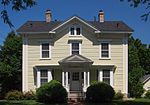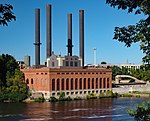Woodbury Fisk House
1869 establishments in MinnesotaHouses completed in 1869Houses in MinneapolisHouses on the National Register of Historic Places in MinnesotaItalianate architecture in Minnesota ... and 1 more
National Register of Historic Places in Minneapolis

The Woodbury Fisk House is a historic house in the Marcy-Holmes neighborhood of Minneapolis, Minnesota, United States, built in 1869. It was listed on the National Register of Historic Places in 1983 for having local significance in the theme of architecture. It was nominated for being the most elaborate example of Italianate architecture—and one of the style's most intact specimens—in the city of Minneapolis.
Excerpt from the Wikipedia article Woodbury Fisk House (License: CC BY-SA 3.0, Authors, Images).Woodbury Fisk House
Southeast 5th Avenue, Minneapolis
Geographical coordinates (GPS) Address Nearby Places Show on map
Geographical coordinates (GPS)
| Latitude | Longitude |
|---|---|
| N 44.986305555556 ° | E -93.248055555556 ° |
Address
Southeast 5th Avenue 424
55414 Minneapolis
Minnesota, United States
Open on Google Maps











